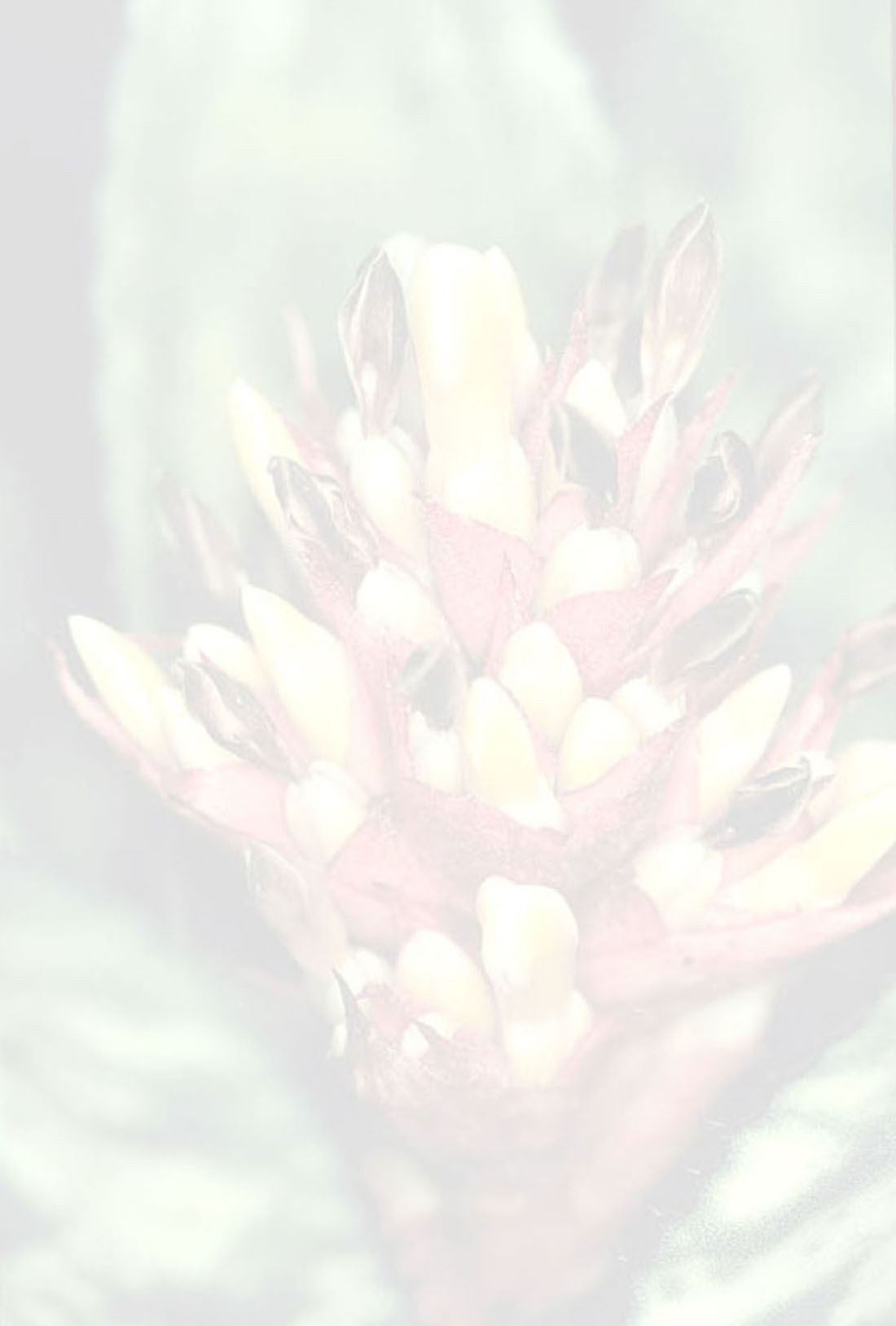

 Aechmea turbinocalyx Mez[as Aechmea turbinocalyx Mez]
Aechmea turbinocalyx Mez[as Aechmea turbinocalyx Mez]Observations: —A P G de Faria & T Wendt in J. Brom. Soc. 54(6): 279-284. 2004
Distribution and Habitat. Aechmea turbinocalyx is endemic to the South region of Bahia State, growing as epiphytic or rupiculous in remains of Atlantic Forest far from the coast, in Jussari and Santa Cruz da Vitoria municipalities, as well as in wet forest and arboreal restinga near the coast, in Aurelino Leal, Ilheus, Una and Urucuca municipalities.
While identifying some species collected during recent field work in Bahia State, Brazil we encountered a case of misnaming involving two species of Aechmea: Aechmea curranii (L.B. Sm.) L.B. Sm. & M.A. Spencer and Aechmea turbinocalyx Mez. The flowers from the problematic specimen lacked appendages, consequently the identification key (Smith & Downs 1979) took us to Streptocalyx Beer, more exactly to Streptocalyx curranii L.B. Sm.This species is currently treated as A. curranii, due to the reduction of Streptocalyx under Aechmea (Smith & Spencer 1992) based on the position that presence or absence of petal appendages only is not enough to separate these two genera. Comparison of our material with other herbarium specimens determined as A. curranii (see material examined) supported our identification. However, when our specimens were compared with the holotype photograph of A. curranii (FIGURE 25A), we noted several differences leading us to suspect that the herbarium specimens determined as A. curranii might be misidentified. Our suspicion was confirmed upon examination of the holotype photograph and original description of A. turbinocalyx (FIGURE 25B), a species known by the type collection only, for Bahia State, without exact locality.
A notable feature of A. turbinocalyx, which is also present in the herbarium specimens analyzed and individuals collected in the field are the convolute sepals, which have a turbinate aspect due to the rolling of the lateral wings to the left. Furthermore, the sepal apices are strongly turned to the left, placing the apiculus horizontally (FIGURE 26A, B).
When compared, the original descriptions of A. curranii and A. turbinocalyx show many similar morphological characters . However, the strong left-hand torsion of the sepal apex is distinctive for A. turbinocalyx. Smith (1931) described the sepals of A. curranii as asymmetrical only, and the drawing presented does not show torsion of the lateral wings as observed in A. turbinocalyx. A. curranii also appears to have the leaf margin more densely serrate, with longer spines, besides an inflorescence more branched (from 5-7 branches, according to Smith & Downs, 1979).
A better delimitation between A. curranii and A. turbinocalyx will depend on more field collections. Among the herbarium material analyzed, we did not observe any collection that could fit in the morphological pattern of A. curranii, based on our comparisons with the type and original description. Besides the type, collected in forests of Rio Gongogi Basin, Smith & Downs (1979) cited one single additional specimen for A. curranii (Foster 51, Agua Preta, Bahia, deposited in GH), however, this was not examined.
Though the type specimen of A. turbinocalyx has a simple inflorescence, after examination of the multiple herbarium specimens we conclude that some individuals can also present bipinnate inflorescences, with 2-4 branches, as well as pseudosimple inflorescences, with few and very short branches that give an aspect of a simple inflorescence (FIGURE 27). As for the leaf margin, it can be entire, the common state, to laxly spinulose. A feature mentioned in the original description of A. turbinocalyx, which can be misleading, is related to the floral bract length. Mez (1892) described the floral bracts as about equaling the sepals. However, all specimens analyzed from herbarium material and collected in the field show shorter floral bracts, equal to or slightly exceeding the ovaries.
The misnaming of herbarium collections is only one problem involving A. turbinocalyx. We also find problems related to infrageneric placement. When first described in 1892 by C. Mez in Flora Brasiliensis, A. turbinocalyx was treated in subgenus Pothuava (Baker) Baker. In the subsequent revisions by Mez (1896,1935), the species was maintained in subgenus Pothuava, being treated in the same way in other studies (e.g., Smith 1955). Smith & Downs (1979) later transferred Aechmea turbinocalyx from subgenus Pothuava to Macrochordion (de Vriese) Baker. This study shows that A. turbinocalyx must be segregated from subgenus Macrochordion, which includes species with strobilate inflorescences, carinate floral bracts, and appendage petals, among other characters that are not shared with A. turbinocalyx.
Aechmea turbinocalyx shows a closer affinity to Aechmea curranii, currently placed in subgenus Aechmea (Smith & Spencer 1992). White flowers and other characters related to the intracalyx morphology such as patent to slightly recurved petals and absence of petal appendages also distinguish Aechmea turbinocalyx from other species of subgenus Aechmea such as A. amorimii Leme, A. floribunda Martius ex Schultes f., A. lanata (L.B. Sm.) L.B. Sm. & Spencer and A. lingulata (L.) Baker. However, since most of the genera and subgenera in Bromelioideae do not correspond to natural groups (Faria et. al. 2004) further studies are necessary to direct the placement of this species within the subfamily. [Editor's note: H. Luther, pers. com., suggests that the above-mentioned taxa can be placed in the taxon Wittmackia Mez].
As Mez (1892) was unable to observe the intracalyx morphology for A. turbinocalyx and as the original description does not reflect fully the variation of inflorescence patterns, we present here a more complete description for this taxon.Edited from (20-04-2023): Faria & Wendt 2004. The real identity of Aechmea turbinocalyx. .